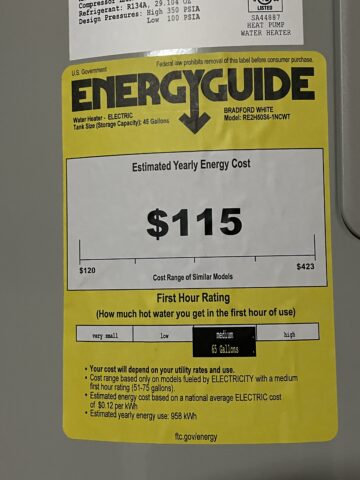Opting for an electric heat-pump hybrid water heater can add up to significant cost and energy savings plus curb your greenhouse gas emissions.
Dory Larsen | January 2, 2021 | Climate Change, Energy EfficiencyElectric Hybrid Heat Pump Water Heaters: The Gift That Keeps On Giving
This Christmas, Santa brought me an energy efficient electric hybrid heat pump water heater. I’m not sure how it fits on the sleigh, but I’m so thankful I’m in hot water with Santa! All kidding aside, our house was built in 1999 and the water heater was original to the house (hot water heaters typically don’t last 20 years) so we were on borrowed time. We started researching options and needless to say, learned quite a bit has changed in terms of energy efficiency with these appliances. Typically, the water heater is the second greatest source of energy consumption in our homes (behind cooling and heating).

Energy Efficient Appliances Really Save Money
Our old water heater consumed an average 5,000 kilowatt hours (kWh) annually. We pay about $.12 per kWh of electricity so that means we were paying about $600 per year to run our water heater. Over the 17 years we’ve lived here we’ve spent over $10,000 on hot water. Yikes! Our new Bradford White water heater is an electric heat-pump hybrid. The technology works like a refrigerator in reverse. It pulls hot air in (thereby heating the water some with ambient air) and pumps cold air out.
So in the summer, our garage will be about 10 degrees cooler AND it only uses about 958 kWh per year. That means we will be spending about $115 per year to run our new water heater. We paid $2,300 for the new unit and installation by our plumber. If we had replaced our old water heater with a typical 50-gallon conventional water heater it would cost about $1,000 for the unit and installation.
Additionally, there is a $300 one-time Federal Tax Credit because it’s an Energy Star appliance. These credits are designed to encourage the purchase of energy-efficient appliances that reduce the demand for electricity, reduce the cost to run, and reduce greenhouse gas emissions. The electricity cost savings of about $500 per year means that even though the new heat pump is $1,000 more expensive upfront (compared to a conventional heat pump) we estimate the higher cost will be recouped by year three, if not sooner. From then on, it’s just money in the bank. Plus, far fewer electrons being used each year which means fewer greenhouse gases being emitted.
Why Don’t We All Install Energy Efficient Appliances?
When our plumber was installing the new unit I asked him why more people aren’t installing these. We had just had a super dorky conversation about saving money and energy –he’s very passionate about his work– and he said “I guess, people just don’t know about it.” So I decided to share my news!

My favorite holiday movie is Elf and I’m reminded of Will Ferrell’s gleeful expression “the best way to spread Christmas cheer is singing loud for all to hear.” Think of me like a jubilant Buddy the Elf (minus the singing) and getting super excited about saving money and watts.
Wishing everyone a Happy Healthy New Year and if you are in the market, consider ringing it in with a new energy efficient water heater!